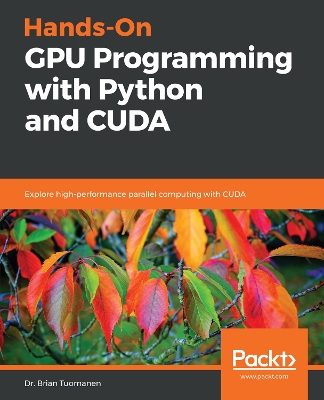Build real-world applications with Python 2.7, CUDA 9, and CUDA 10. We suggest the use of Python 2.7 over Python 3.x, since Python 2.7 has stable support across all the libraries we use in this book.
Key FeaturesBook Description
- Expand your background in GPU programming—PyCUDA, scikit-cuda, and Nsight
- Effectively use CUDA libraries such as cuBLAS, cuFFT, and cuSolver
- Apply GPU programming to modern data science applications
Hands-On GPU Programming with Python and CUDA hits the ground running: you’ll start by learning how to apply Amdahl’s Law, use a code profiler to identify bottlenecks in your Python code, and set up an appropriate GPU programming environment. You’ll then see how to “query” the GPU’s features and copy arrays of data to and from the GPU’s own memory.
As you make your way through the book, you’ll launch code directly onto the GPU and write full blown GPU kernels and device functions in CUDA C. You’ll get to grips with profiling GPU code effectively and fully test and debug your code using Nsight IDE. Next, you’ll explore some of the more well-known NVIDIA libraries, such as cuFFT and cuBLAS.
With a solid background in place, you will now apply your new-found knowledge to develop your very own GPU-based deep neural network from scratch. You’ll then explore advanced topics, such as warp shuffling, dynamic parallelism, and PTX assembly. In the final chapter, you’ll see some topics and applications related to GPU programming that you may wish to pursue, including AI, graphics, and blockchain.
By the end of this book, you will be able to apply GPU programming to problems related to data science and high-performance computing.
What you will learnWho this book is for
- Launch GPU code directly from Python
- Write effective and efficient GPU kernels and device functions
- Use libraries such as cuFFT, cuBLAS, and cuSolver
- Debug and profile your code with Nsight and Visual Profiler
- Apply GPU programming to datascience problems
- Build a GPU-based deep neuralnetwork from scratch
- Explore advanced GPU hardware features, such as warp shuffling
Hands-On GPU Programming with Python and CUDA is for developers and data scientists who want to learn the basics of effective GPU programming to improve performance using Python code. You should have an understanding of first-year college or university-level engineering mathematics and physics, and have some experience with Python as well as in any C-based programming language such as C, C++, Go, or Java.
- ISBN10 1788993918
- ISBN13 9781788993913
- Publish Date 27 November 2018
- Publish Status Active
- Publish Country GB
- Imprint Packt Publishing Limited
- Format Paperback
- Pages 310
- Language English
- URL https://packtpub.app.onixsuite.com/book/?GCOI=89543100504640
